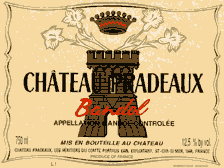
The 2005 Show had to be flawed as I did some research on flawed wines and deduced it had to be oxidized. Most of my experience with flawed wines have been at restaurants were the wines were “corked” or “cooked”. A severely corked wine smells and sometimes tastes like a rotten wet newspaper or sweaty chunk of cardboard was put in the bottle at the time the wine was bottled. Usually the wine's aroma is reticent of wet paper or cardboard funk, even sometimes like a dank basement. The wine tastes muted, almost dead. Less severely corked wines show the same characteristics, but are much less evident and usually go unnoticed by the average wine drinker. The easiest way to tell if your wine is corked and you are not an experienced taster is to have a bad bottle of a wine you drink a lot of and usually enjoy its consistency. Corked wines are from TCA, an abbreviation for 2,4,6-Trichloroanisole, a really long word that is really not that important to most of you out there except for the fact it may have ruined a wine or two in your past you thought was too funky. TCA is part fungi, part chemical agent and mostly found in contaminated corks or strips of cork before they are processed into wine bottle corks, ergo the term “corked”. A "corked" wine is harmless to consume, but if you detect it send the wine back to the sommelier or the store you bought it from. If they are worth their salt, both will take it back no questions asked.
It is estimated that 1%-15% of all wines are corked. The wide range is part industry folk who say the rate of contamination is less than 2% and screw cap advocates that estimate it is as high as 15%. A good estimate is likely something in the neighborhood of 7%. There is an ever growing argument to use screw caps to seal immediate consumption wines. I agree with that idea but feel cork is necessary for wines of pedigree and aging potential as the cork allows the wine to slowly breathe allowing for a slow evolution, producing a classically aged wine. Screw caps can do too much of a good thing and retard evolution of fine wines meant to age, as well as encapsulate sulfur aromas from the sulfur used in many wines as a preservative in wine making to prevent oxidation or spoilage when racking and bottling wines at the winery. Google the term “Mollydooker Shake” to see how to rid a wine of any sulfur aromas.
A cooked wine tastes ok if its young enough, but the texture is all off because sometimes an effervescence is created, or it’s so cooked it tastes burnt or caramel like, absent of fruit and brown in color. “Cooked” wines are the result of poor storage in wine racks in a kitchen, in direct sunlight in a living room, or any other storage space where the temperature changes are volatile.
An oxidized wine is from a bad cork that dried up or was too small. Air is allowed into the wine and the fruit in the wine turns and it loses it life and fruit vibrancy, leaving behind the tannin, oak and acid – not a great tasting experience mind you. That is what the 2005 Show tasted like and therefore I do feel it was compromised after tasting the 2006 Show. This is why it is important to store wines for aging in a humidified environment so the cork does not dry out. The 2005 Show lacked any fruit. The 2006 contained copious amounts of fruit and oak. One flavor was familiar to the 2005: lots of oak and vanillin from toasty barrels (a bit too much for my taste), in addition to some wonderful ripe fruit that took about an hour to wake up from its slumber.
Tasting Notes: The color was a pleasing dark purple, a promising typicity for a California Cabernet. After an hour the wine took on some weight and the following notes are from that time as the wine at first seemed a bit disjointed, possibly because of its youth. Many wines need time in bottle after barrel aging to come together after the initial “bottle shock”. Oak, vanilla, some green pepper and cherry fruit emerged from the wine’s aromas. On the palate copious amounts of sweet vanilla and toasty oak meet some pepper, and generous cherry and grape flavors. The tannins are reserved and almost too subtle. A touch of heat on the finish completes the package. This is a nice wine to have with a nice steak or beef dish that can stand up to the ripe fruit and oak flavors. I will probably try this again in a few months after the wine settles down in bottle.
However if I were the winemaker I would be more judicious with the oak treatment and maybe use a screw cap instead of a cork as this wine is meant to be drunk now and a cork is a waste on a wine meant for immediate consumption.
The Show comes in these 3 eye-catching lables:
Cheers!





